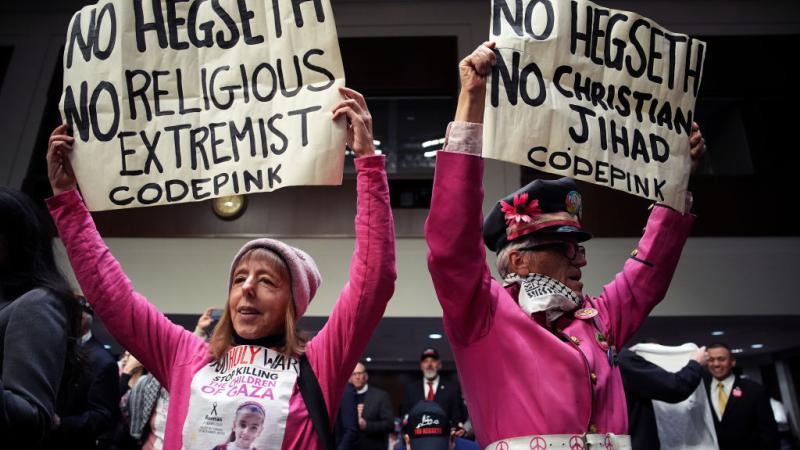Power plant construction in U.S. Baghdad embassy was over budget, violated federal rules: watchdog
The multimillion dollar construction of the power plant at the U.S. Embassy in Iraq has come under scrutiny by the State Department's inspector general at a time when the U.S. presence in Iraq is being threatened by renewed anti-American sentiment.
After more than $100 million was spent to construct a power plant at the U.S. Embassy in Baghdad, Iraq, the plant reportedly has multiple deficiencies and continues to need costly repairs on the taxpayer dime.
The State Department's Office of Inspector General found that the U.S. State Department did not follow proper federal and agency guidelines during its planning, construction, and commissioning of the power plant, leading to cost overruns and deficiencies in its construction and operation.
The watchdog’s new report highlights just one of the issues at Embassy Baghdad, the largest U.S. embassy in the world and located in the heart of a country that has become increasingly hostile to the United States since the Iraq War.
The Embassy Baghdad power plant project began during the Obama Administration, but it did not come online until 2018. Yet despite its completion, the project’s problems will likely continue to incur costs for the taxpayer into the future, the OIG found.
“The Department did not always follow federal and Department requirements and guidelines in the planning, design, and commissioning of the new central power plant at Embassy Baghdad and missed opportunities to correct identified deficiencies at each project phase, even during the construction phase when the deficiencies became apparent,” the OIG concluded in the report.
Among the guidelines that the State Department Office of Acquisitions Management (AQM) and the Bureau of Overseas Buildings Operations (OBO) failed to follow, the report found, were “federal regulations regarding fair and reasonable pricing” and “requirements for selecting the most highly qualified architect-engineer” at a “reasonable price.”
You can read the report below:
According to the OIG, a key and glaring error of State Department officials was the sharing of an independent government cost estimate with a prospective contractor. Government officials told the initial contractor that a “guesstimate” for the project would be $1.5 million. Thirteen days later, the prospective contractor for site planning returned a proposal for $1.49 million. By federal regulation, specifically FAR 36.605, the “guesstimate” is not allowed to be shared with contractors, except when it is used in negotiations to obtain a fair price.
The OIG concluded that this breach resulted in the department lacking “assurance that it had paid a fair and reasonable price for the requested services.”
In total, the cost of the power plant in total was nearly $76 million more than planned. Part of this involved 23 contract modifications under the original order, 17 of which added additional services that cost more than $13 million. The OIG determined that many of these contract modifications were “out-of-scope,” meaning that they were not approved or related to the original project orders.
These are not the only issues that the OIG found. Investigators also discovered that there’s no “documented justification explaining the rationale for the new central power plant,” from the time that the project began in 2009 to its completion in 2018. Without this documentation, “Department officials were unable to attest to the necessity for a new central power plant or justify the resource investment.”
In addition to cost overruns and the lack of a clear rationale for building a new power facility at the embassy in the first place, the plant has been plagued by problems that have led to increased costs for repairs, even though many of those deficiencies were discovered during construction.
In 2012, in anticipation of the plant's completion, RMF Engineering, Inc. was retained to commission the plant. In its December 2019 commissioning report, the firm concluded that overall the power plant was fully functional and a quality product, however, it identified deficiencies from construction that needed correction, according to the OIG report.
Because of the deficiencies during its construction the "plant has experienced significant performance problems and operational deficiencies, including multiple unplanned power outages and generator failures, that have negatively impacted embassy operations and raised security and safety concerns,” the report said.
Some of the problems that the firm identified are redacted in the report, however, the OIG detailed high temperatures in the generator room, borne from poor ventilation and failure to follow manufacturer instructions. This issue was brought to the architect’s and the State Department’s attention during construction, but apparently no action was taken to remedy this issue.
The OIG also identified two instances of the “catastrophic failure” of a generator, in June 2019 and May 2023, which incurred significant repair costs and loss of capacity. These failures resulted in explosions that “could have injured or killed anyone who had been near them,” according to the report.
“[A] defective power plant may require more repairs than a well-functioning one, resulting in additional costs for parts and labor and interruptions to power generation,” the report reads, after highlighting the incidents and the State Department’s failure to address potential defects in construction.
The State Department did not respond to a request for comment from Just the News about the findings of the OIG report and how the Department plans to avoid the missteps of the power plant construction in the future.
In response to the OIG’s findings, the AQM specifically highlighted its October 2023 revision to the Department of State Acquisitions Manual, which the State Department agency said addressed the concerns and recommendations of the OIG with regard to procurement.
The OBO, in its response to the OIG, expressed that the OIG’s report should reflect that expediting the power plant project was for “security and life safety needs at Embassy Baghdad, a Critical Threat post.” The bureau also concurred with most of OIG’s recommendations and vowed to ensure better management of projects in the future.
In recent years, the expansive U.S. Embassy in Iraq has been at the center of concerns about Iran’s increasing influence in the country and a growing anti-American population in Baghdad, giving rise to concerns about U.S. efforts to maintain the facility.
After President Trump ordered the airstrike that killed Iranian general Qasem Soleimani in January 2020 for his terrorist activities in the Middle East, the Iraqi government and its citizens reacted negatively. The Iraqi parliament voted to expel U.S. troops from the country, a measure carried by the Shia lawmakers who are aligned with Iran.
“Iraqi priorities and the US are increasingly at odds,” former Prime Minister of Iraq Abdul Mahdi said during an address to the parliament, according to CNN.
In January 2020 between a quarter to half a million Iraqi citizens protested in Baghdad, demanding that American forces leave the country. Time magazine reported that these protests and the killing of Soleimani coincided with the rising power of pro-Iranian political coalitions in the country, giving them the leverage they needed to exert pressure on the then-Prime Minister to demand a U.S. withdrawal. This marked a turning point from Iraq’s dependency on the United States to beat back the Islamic State in prior years.
A year later, tensions escalated again as the U.S. embassy came under rocket fire from Iranian-backed militias operating in the country. Though the political leadership had changed and the Iraqi government worked to convince President Trump to keep American forces there, Secretary of State Mike Pompeo threatened that the U.S. would close its huge embassy in the capital if Iraqi forces did not stop the attacks.
Today, the Israel-Hamas war has sparked another point of contention with the Iraqi populace. In the protests following the hospital strike in Gaza erroneously blamed on the Israeli Defense Forces, portraits of Iran’s Supreme Leader Khamenei and Hezbollah leader Nasrallah were spotted in a crowd of protestors gathered in Baghdad, signaling their anti-American views.
The U.S. military has also prevented drone attacks against its forces across the country. Attacks on U.S. forces throughout the region have been a steady occurrence since the beginning of the Israel-Hamas war, with only minimal U.S. retaliation. Recently, American troops were attacked at least 4 times in both Iraq and Syria over the Thanksgiving holiday.
As the largest U.S. embassy in the world in an area growing unfriendly to the United States and vulnerable to enemy attack, some have criticized maintaining the facility that required its own power plant in the first place.
After Pompeo threatened to close the embassy, Steven Cook, a senior fellow at the Council on Foreign Relations, argued that the massive compound should have been shuttered a long time ago.
“To the extent that any Americans think about Iraq or the U.S. Embassy in Baghdad these days, they likely envision a building, but it is much more than that. The compound, which is only slightly smaller than Disneyland, features 20 office buildings, six apartment blocks, and various amenities for the staff, which at one time numbered 16,000. The tab for the complex’s completion was $750 million,” Cook wrote in Foreign Policy.
“It is the physical manifestation of American hubris in Iraq. And, unlike Disneyland, no dreams came true there,” Cook continued. He argued that a smaller embassy, with a less expansive—and expensive—compound would meet the United States’ security and diplomatic needs.
















